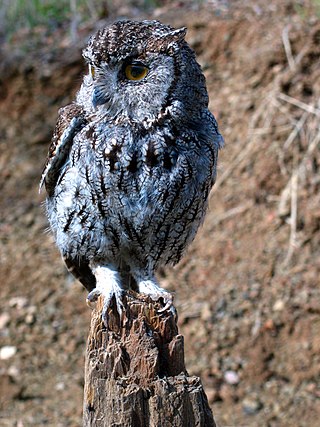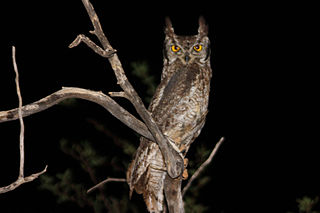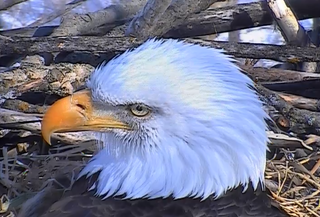
Owls are birds from the order Strigiformes, which includes over 200 species of mostly solitary and nocturnal birds of prey typified by an upright stance, a large, broad head, binocular vision, binaural hearing, sharp talons, and feathers adapted for silent flight. Exceptions include the diurnal northern hawk-owl and the gregarious burrowing owl.

The little owl, also known as the owl of Athena or owl of Minerva, is a bird that inhabits much of the temperate and warmer parts of Europe, the Palearctic east to Korea, and North Africa. It was introduced into Britain at the end of the 19th century and into the South Island of New Zealand in the early 20th century.

The barn owl is the most widely distributed species of owl in the world and one of the most widespread of all species of birds, living almost everywhere except for polar and desert regions, Asia north of the Himalayas, some Indonesian islands and some Pacific Islands. It is also known as the common barn owl, to distinguish it from the other species in its family, Tytonidae, which forms one of the two main lineages of living owls, the other being the typical owls.

The western screech owl is a small owl native to North and Central America, closely related to the eastern screech owl. The scientific name commemorates the American naturalist Robert Kennicott.

The spotted owlet is a small owl which breeds in tropical Asia from North Pakistan to Southeast Asia. A common resident of open habitats including farmland and human habitation, it has adapted to living in cities. They roost in small groups in the hollows of trees or in cavities in rocks and buildings. It nests in a hole in a tree or building, laying 3–5 eggs. The species shows great variation including clinal variation in size and forms a superspecies with the very similar little owl.

The Japanese scops-owl is a small owl species in the family Strigidae, or true owl family. It is a member of the genus Otus, the scops owl genus. It is resident to Japan, China, Korea, and Russia.

The elf owl is a small grayish-brown owl about the size of a sparrow found in the Southwestern United States, central Mexico, and the Baja California peninsula. It has pale yellow eyes highlighted by thin white "eyebrows" and a gray bill with a horn-colored tip. The elf owl frequently inhabits woodpecker holes in saguaro cacti; it also nests in natural tree cavities. It is nocturnal and feeds primarily on insects.
Guardians of Ga'Hoole is a fantasy book series written by Kathryn Lasky and published by Scholastic. The series contains a total of 16 books and although originally intended to conclude with the 2008 publication of The War of the Ember, a prequel, The Rise of a Legend, was published in 2013. Apart from the main series there are a few more books and spin-offs set in the same universe. The first three books of the series were adapted into the 2010 animated 3D film Legend of the Guardians: The Owls of Ga'Hoole, directed by Zack Snyder.

The Philippine eagle-owl is a vulnerable species of owl belonging to the family Strigidae. It is endemic to the Philippines, where it is found in lowland forests on the islands of Catanduanes, Samar, Bohol, Mindanao, Luzon, Leyte and possibly Sibuyan. The Philippine eagle-owl feeds on rodents and amphibians. Due to its reliance on living in large lowland forests, forest conservation is important in order to maintain populations of the Philippine eagle-owl, which is becoming increasingly vulnerable to going extinct. The Philippine eagle-owl was previously listed as endangered, but due to destruction of lowland habitat and possible hunting, the eagle-owl has since been adjusted to the vulnerability of extinction.

The spotted eagle-owl, also known as the African spotted eagle-owl and the African eagle-owl, is a medium-sized species of owl, one of the smallest of the eagle owls. Its length is 45 cm (18 in) and its weight is from 454 to 907 grams. It has a 100 to 140 cm wingspan. The facial disk is off-white to pale ochre and the eyes are yellow. It has prominent ear-tufts, and the upper body is dusky brown, the lower parts off-white with brown bars. Prior to 1999 the spotted eagle-owl was considered conspecific with the greyish eagle-owl, but now it is classed as a separate species.

The black-and-white owl is a species of owl in the family Strigidae.

The Tamaulipas pygmy owl is a species of owl in the family Strigidae. It is endemic to Mexico. This is one of the smallest owls in the world, with a mean length of 13.5 cm (5.3 in). However, at 53 g (1.9 oz), it is slightly heavier than the long-whiskered owlet and the elf owl. Its natural habitat is subtropical or tropical moist montane forests.

The tawny owl, also called the brown owl, is a stocky, medium-sized owl in the family Strigidae. It is commonly found in woodlands across Europe, as well as western Siberia, and has seven recognized subspecies. The tawny owl's underparts are pale with dark streaks, whilst its upper body may be either brown or grey. The tawny owl typically makes its nest in a tree hole where it can protect its eggs and young against potential predators. It is non-migratory and highly territorial: as a result, when young birds grow up and leave the parental nest, if they cannot find a vacant territory to claim as their own, they will often starve.

Legend of the Guardians: The Owls of Ga'Hoole is a 2010 video game adapted for PlayStation 3, Wii and Xbox 360 as well as Nintendo DS. Developed by Krome Studios and published by Warner Bros. Interactive Entertainment, released on September 14, 2010. It is based on the film of the same name, and includes some elements from the books. The game takes place during the events of the movie.

The Decorah Bald Eagles is a website featuring a live-streaming webcam trained on a bald eagle nest and family in Decorah, Iowa. The Raptor Resource Project installed and runs the live stream for research purposes. It is one of more than a dozen eagle webcams across the United States.

The eastern barn owl is usually considered a subspecies group and together with the American barn owl group, the western barn owl group, and sometimes the Andaman masked owl make up the barn owl. The cosmopolitan barn owl is recognized by most taxonomic authorities. A few separate them into distinct species, as is done here. The eastern barn owl is native to southeastern Asia and Australasia.

The western barn owl is usually considered a subspecies group and together with the American barn owl group, the eastern barn owl group, and sometimes the Andaman masked owl make up the barn owl. The cosmopolitan barn owl is recognized by most taxonomic authorities. A few separate them into distinct species, as is done here. The western barn owl is native to Eurasia and Africa.

The American barn owl is usually considered a subspecies group and together with the western barn owl group, the eastern barn owl group, and sometimes the Andaman masked owl, make up the barn owl, cosmopolitan in range. The barn owl is recognized by most taxonomic authorities. A few separate them into distinct species, as is done here. The American barn owl is native to North and South America, and has been introduced to Hawaii.

Tawny owls are monogamous and territorial year around. Young birds select territories and look for mates in autumn and tend to be very vocal, especially males. Due to their highly territorial behaviour, young birds frequently struggle to establish a territory unless a nearby adult dies. Males routinely engage in territorial fights. Territories have been known to have been maintained by single tawnys for up to 10 years in Russia and 13 years in Berlin. Of 34 males in Wytham, only one male moved off of territory, due to being disturbed by humans. It appears to be largely up to the male to select territorial boundaries. Despite the aforementioned territorial behaviour, active nests of two separate pairs at as close as 100 m (330 ft), in the Tegel forest, have been reported. This species shows very little extrapair parentage. In Switzerland for example, a study of 137 nestings found that only one, or 0.7%, were from a different father than the mate, females cannot generally raise young without male contribution so the pair structure of these highly residential owls insures little instance of cuckoldry. Cases of bigamy were reported at Wytham in 6 of 34 males, in situations where apparently a neighboring male died and was suffixed subsequently, however, one or the other nesting attempts would completely fail each time. In Pavia, 3 of 22 territories included two mature females.
















